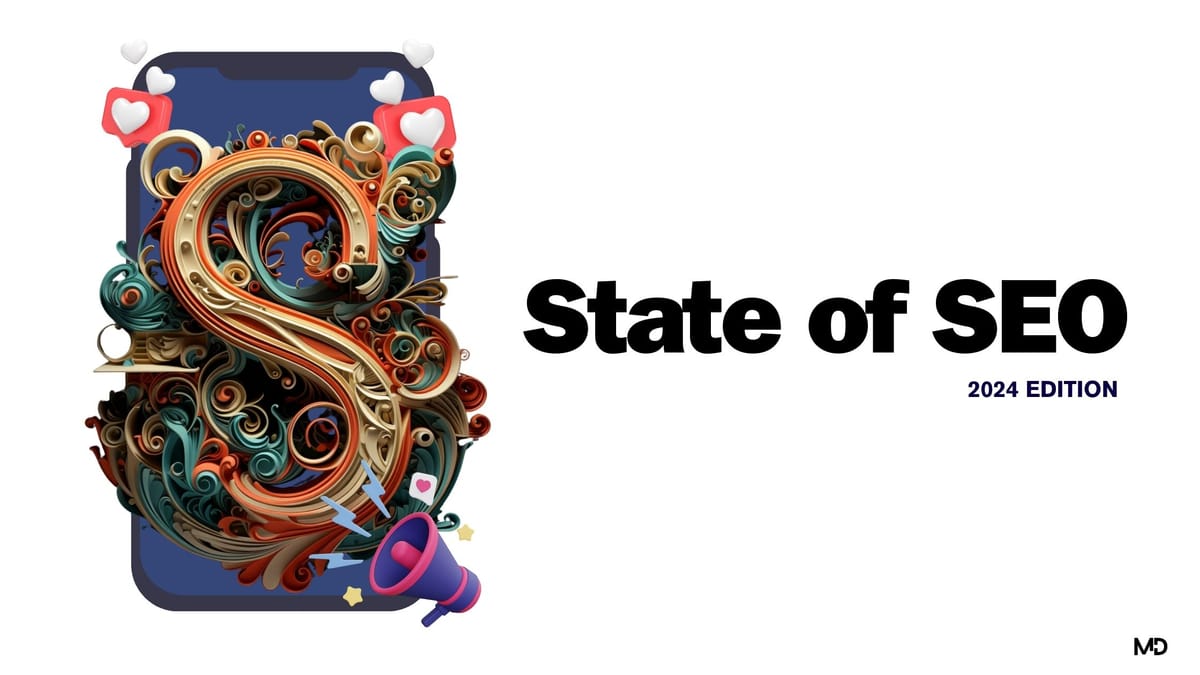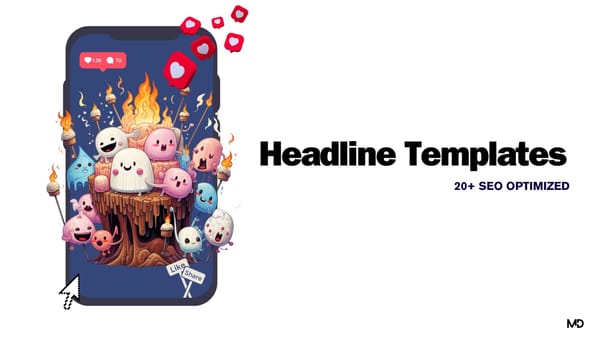What is the future of SEO in 2024?

As we step into 2024, the SEO landscape is buzzing with new trends that are as exciting as they are challenging.
93% of online experiences start with a search engine. Whether you're a seasoned pro or just dipping your toes into the vast ocean of SEO, knowing and understanding these trends are crucial.
We're not just talking about keeping up; it's about staying ahead.
Without further ado, let's jump right into it.
Trend #1: AI and Machine Learning
No. We're not talking about creating a bazillion low-quality articles using ChatGPT. That's a different kind of discussion.
AI's role in effective SEO is primarily focused on predictive analysis. This involves using data to forecast search trends and user interests, enabling businesses to anticipate and respond to market changes proactively. The key advantage here is the ability to optimize content and keywords not just based on current data but also on projected search patterns and preferences.

From Influencer MarketingHub's Artificial Intelligence (AI) Marketing Benchmark Report: 2023
Highly ranked content still delivers the most traffic, some as high as 75% of all trackable website traffic for B2Bs. Social media traffic, however, remains flat and below 10%.

From Bright Edge Research's Channel Report
When AI and ML are added into the mix, approximately 21.33% of companies have reported a revenue boost ranging from 6% to 10% after embracing artificial intelligence.

From Statista's Worldwide AI Revenue Increase
AI and ML are making a substantial impact through their assistance in content strategy. By evaluating user interactions and engagement, these technologies provide insights into the types of content that are most likely to resonate with audiences. This goes beyond optimizing for search engines; it's about creating content that aligns with user interests and behaviors, thereby improving engagement and relevance.

From Ascend2’s report: State of Marketing Automation 2022
Trend #2: Voice Search Optimization
The shift towards voice-activated devices has significantly altered search queries, making them more conversational and leaning towards long-tail keywords.
27% of people are using voice search on mobile, with the average being 29 words in length. The increase of people using voice assistants has increased from 79.9 million in 2017 to 125.2 million in 2023.

From Insider Intelligence's How big is the voice assistant market?
For instance, instead of typing "weather New York," a voice search might be "What's the weather like in New York for Thursday?" This change reflects the natural language used in voice searches, requiring a different approach to SEO.
The rise in voice search is mostly due to its ease of usage, with 90% of people using voice search reporting much easier to work with than searching online.

From Insider Intelligence's How big is the voice assistant market?
We can optimize voice search by optimizing conversational phrases in the copy. The goal is to align with the natural language patterns of users, ensuring that their queries lead to relevant results. This involves not only keyword optimization but also refining the overall content structure and information delivery to be more in tune with voice search dynamics.

From Demand Sage's Voice Search Statistics
Trend #3: Mobile-First Indexing
Mobile-first indexing isn't exactly brand new. It's been around the block since 2020, with the switch to mobile-first occurring in September 2020. Traditionally, Google ranked websites based on desktop versions. However, the share of global mobile website traffic has now surpassed 50% average across all continents.

From Statista's Mobile internet traffic as percentage of total web traffic in January
73.1% of web designers believe that non-responsive designs are the top reason why users disengage with a website. This sentiment is justified. Websites that are not optimized for mobile devices risk losing visibility in search engine results. Why? Because Google aims to provide the best user experience, which now predominantly occurs on mobile devices.

From Think with Google's Marketing Strategies
The content layout also requires adaptation for mobile-first indexing. This involves organizing content in a way that is easily digestible on mobile devices.
Trend #4: User Experience (UX) and SEO
UX includes the content that's being presented to the user. The merger between UX and SEO means that a positive on-site experience will lead to better rankings.
Long paragraphs of text can be overwhelming on a small screen, so breaking text into smaller, more manageable sections with clear headings is essential.
The mean word count of a Google first page result is 1,447 words.

From Backlinko's Here's What We Learned About SEO
Ensuring that essential information is not hidden in tabs or accordions, which might not be immediately visible on mobile devices, is crucial for maintaining visibility and user engagement.
These factors are one of the many ways to increase your overall dwell time, which is the time a Google spends on your content before hitting the back button. The longer the dwell time, the more useful your content is for the user.
The average dwell time for a first-page result is approximately 2.5 minutes. This high time on site is a byproduct of high-quality content - and it shows in what Google displays on the first-page search results.

From Backlinko's Here's What We Learned About SEO
Trend #5: Local SEO for Global Reach
Local SEO is emerging as a vital strategy for businesses targeting a global audience. Key statistics underline the importance and effectiveness of local SEO in driving customer engagement and sales. 46% of all Google searches are for local information, highlighting the vast audience actively seeking local business details online.
Local search is known for its high engagement, offering the highest ROI and most page views per session compared to other channels. 72% of consumers who perform a local search visit a store within five miles, demonstrating the immediate impact local SEO can have on driving physical store traffic.
Local SEO involves two main aspects as Google displays two types of search results for local queries: "map pack" results and organic "blue link" results. It's possible to rank well in both of these result types.

The influence of Google in local searches is significant, with 87% of customers using Google to evaluate local businesses. Moreover, “near me” searches have grown exponentially, with a 900% increase over two years, reflecting the growing trend of consumers seeking local solutions for their needs.
Trend #6: Content that Satisfies Search Intent
One of the most critical aspects of SEO is creating content that aligns with user search intent. Understanding and catering to the various types of search intent – informational, transactional, navigational, and investigational – has become essential for achieving high rankings and engaging users effectively.
With informational intent, users are seeking information or answers. In one case study, optimizing for searcher intent led to a 516% increase in traffic in less than six months for a specific landing page.

From ahref's Search Intent in SEO: What It Is & How to Optimize for It
When it comes to transactional search intent, users exhibit a clear intent to complete a task or make a purchase. This intent is marked by searches with keywords like "buy," "order," or "deal," or brand-specific searches. For instance, users might search for "buy Microsoft Surface Pro" or "HubSpot CRM pricing."
Additionally, location-based and comparison searches are common in transactional intent - which loops us back to local SEO - where users may look for the best deals or reviews before making a purchase, like "best pizza restaurants in New Orleans" or "iPhone 12 vs iPhone 13"
Trend #7: SERP Feature Optimization
SERPs - or Search Engine Results Pages - is how Google responds to search queries. It's what Google shows users based on their search queries.

However, nowadays, you don't just get results back - you also get rich snippets, paid results, knowledge graphs, and a dozen other features that Google picks and chooses to display to you based on your search journey.
While SERPs are great, they also take up a lot of screen real estate. No-click searches are increasing due to SERPs. This means that even if you end up on the first page and second result, the first result SERPs may draw all potential attention away.

From SparkToro's Google CTR in 2018: Paid, Organic, & No-Click Searches
The “People also ask” box appears on 78.85% of SERPs, while videos, carousels, and images appear on 52.84%, 51.65%, and 37.81% of SERPs, respectively.
Optimizing content for Search Engine Results Page (SERP) features has become a key SEO trend. These features often capture significant user attention and can drive substantial traffic to your website.
Trend #8: E-A-T Principle and its importance
E-A-T, which stands for Experience, Expertise, Authoritativeness, and Trustworthiness in content, significantly impacts SEO and website rankings. It is also a copywriting and content presentation methodology to build trust, authority, and quality content. The concept is also important enough that Google's made it official in what qualifies as a factor in SEO ranking.
So what does applied E-A-T look like?
Applied E-A-T looks like a combination of expertly crafted content, authoritative recognition, and a strong foundation of trust. To start, expertise is showcased through well-researched and comprehensive content, authored by individuals with relevant qualifications or experiences. This includes in-depth articles, detailed guides, and user engagement, such as comments and shares, which further validate the content's value. The content should align with user intent, providing clear, engaging, and unique insights into the topic at hand.
In terms of authoritativeness, it involves building a reputation as a credible source within your niche. This can be achieved by earning high-quality backlinks from esteemed websites, gaining industry recognition, and maintaining a consistent flow of authoritative and up-to-date content. Incorporating positive user reviews and ratings, especially for local businesses, also plays a crucial role in enhancing your website's authority. This aspect also includes avoiding conflicts of interest and being transparent about any sponsored content or affiliations.

From Search Logistics' Link Building Statistics that Prove You Need To Build Links
Trustworthiness is established through robust website security (using HTTPS), transparent content practices, comprehensive privacy policies, and easily accessible contact information. Trust is further reinforced by avoiding thin, duplicate, or misleading content and ensuring all information is factually accurate and verifiable. The integration of diverse multimedia and internal linking strategies can also contribute to a trustworthy and user-friendly experience on your site.
Trend #9: Sustainable and Ethical SEO
The emphasis on sustainable and ethical SEO practices has become more pronounced, playing a crucial role in building and maintaining long-term brand credibility. Sustainable SEO refers to strategies that focus on achieving lasting results through ethical means, rather than seeking quick wins that might involve manipulative tactics. This approach is rooted in creating a positive user experience, adhering to search engine guidelines, and providing genuine value to the audience.
Below is a case study from Semrush that shows the negative effects of black hat techniques, resulting in zero visibility of the site in search trends over time.

From Semrush's What is Black HAT SEO? 9 Risky Techniques to Avoid
The importance of ethical SEO practices stems from the growing awareness and intolerance among both search engines and users towards deceptive tactics, such as keyword stuffing, cloaking, or using private link networks. These practices, often referred to as "black-hat SEO," can lead to penalties from search engines, damaging a brand's reputation and trustworthiness.
Conversely, ethical SEO practices, often termed "white-hat SEO," focus on producing high-quality, relevant content, ensuring website accessibility and user-friendliness, and building natural backlinks.
Trend #10: Advanced Link Building Techniques
The realm of link building has undergone significant evolution, transitioning from quantity-focused strategies to more sophisticated, quality-oriented practices. The importance of building high-quality backlinks remains important in SEO, but the methods and approaches have become more advanced and nuanced.
Historically, link building was often about garnering as many links as possible, regardless of the source. This approach led to practices like link farms and paid link schemes. However, search engines have since become more adept at identifying and penalizing these tactics, emphasizing the need for genuine, relevant, and valuable links.

Example of a link penalty from Google's Search console. From linkbuilder.io's Unnatural Links: How to Avoid a Google Penalty
The current best practices in link building focus on earning links rather than merely creating them. This involves producing high-quality content that naturally attracts backlinks because of its usefulness, relevance, or uniqueness. Content that provides comprehensive information, original research, unique insights, or practical resources is more likely to earn organic backlinks from reputable sources.
What you can do right now
Quality content is at the heart of SEO. It's not just about meeting SEO criteria but about providing genuine value to your audience. This approach not only satisfies search engines but fosters trust and authority among your readers, laying a strong foundation for long-term digital success.
In short, focus on quality content and your SEO results will excel.
To help you in this endeavor, I've created an exclusive E-E-A-T Scorecard Metric. It's a practical tool for assessing and improving your content according to the E-E-A-T principles.
That's it for this week. Stay tuned for next week's insights.





